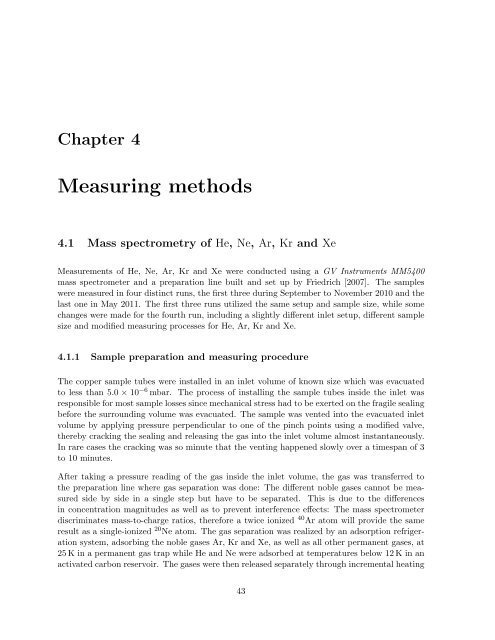Diploma thesis in Physics submitted by Florian Freundt born in ...
Diploma thesis in Physics submitted by Florian Freundt born in ...
Diploma thesis in Physics submitted by Florian Freundt born in ...
Create successful ePaper yourself
Turn your PDF publications into a flip-book with our unique Google optimized e-Paper software.
Chapter 4<br />
Measur<strong>in</strong>g methods<br />
4.1 Mass spectrometry of He, Ne, Ar, Kr and Xe<br />
Measurements of He, Ne, Ar, Kr and Xe were conducted us<strong>in</strong>g a GV Instruments MM5400<br />
mass spectrometer and a preparation l<strong>in</strong>e built and set up <strong>by</strong> Friedrich [2007]. The samples<br />
were measured <strong>in</strong> four dist<strong>in</strong>ct runs, the first three dur<strong>in</strong>g September to November 2010 and the<br />
last one <strong>in</strong> May 2011. The first three runs utilized the same setup and sample size, while some<br />
changes were made for the fourth run, <strong>in</strong>clud<strong>in</strong>g a slightly different <strong>in</strong>let setup, different sample<br />
size and modified measur<strong>in</strong>g processes for He, Ar, Kr and Xe.<br />
4.1.1 Sample preparation and measur<strong>in</strong>g procedure<br />
The copper sample tubes were <strong>in</strong>stalled <strong>in</strong> an <strong>in</strong>let volume of known size which was evacuated<br />
to less than 5.0 × 10 −6 mbar. The process of <strong>in</strong>stall<strong>in</strong>g the sample tubes <strong>in</strong>side the <strong>in</strong>let was<br />
responsible for most sample losses s<strong>in</strong>ce mechanical stress had to be exerted on the fragile seal<strong>in</strong>g<br />
before the surround<strong>in</strong>g volume was evacuated. The sample was vented <strong>in</strong>to the evacuated <strong>in</strong>let<br />
volume <strong>by</strong> apply<strong>in</strong>g pressure perpendicular to one of the p<strong>in</strong>ch po<strong>in</strong>ts us<strong>in</strong>g a modified valve,<br />
there<strong>by</strong> crack<strong>in</strong>g the seal<strong>in</strong>g and releas<strong>in</strong>g the gas <strong>in</strong>to the <strong>in</strong>let volume almost <strong>in</strong>stantaneously.<br />
In rare cases the crack<strong>in</strong>g was so m<strong>in</strong>ute that the vent<strong>in</strong>g happened slowly over a timespan of 3<br />
to 10 m<strong>in</strong>utes.<br />
After tak<strong>in</strong>g a pressure read<strong>in</strong>g of the gas <strong>in</strong>side the <strong>in</strong>let volume, the gas was transferred to<br />
the preparation l<strong>in</strong>e where gas separation was done: The different noble gases cannot be measured<br />
side <strong>by</strong> side <strong>in</strong> a s<strong>in</strong>gle step but have to be separated. This is due to the differences<br />
<strong>in</strong> concentration magnitudes as well as to prevent <strong>in</strong>terference effects: The mass spectrometer<br />
discrim<strong>in</strong>ates mass-to-charge ratios, therefore a twice ionized 40 Ar atom will provide the same<br />
result as a s<strong>in</strong>gle-ionized 20 Ne atom. The gas separation was realized <strong>by</strong> an adsorption refrigeration<br />
system, adsorb<strong>in</strong>g the noble gases Ar, Kr and Xe, as well as all other permanent gases, at<br />
25 K <strong>in</strong> a permanent gas trap while He and Ne were adsorbed at temperatures below 12 K <strong>in</strong> an<br />
activated carbon reservoir. The gases were then released separately through <strong>in</strong>cremental heat<strong>in</strong>g<br />
43
















